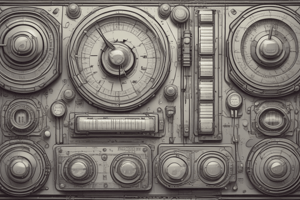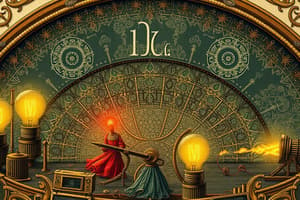Podcast
Questions and Answers
What components are essential for a simple electric circuit?
What components are essential for a simple electric circuit?
- A battery, load, and conducting wires (correct)
- A fuse, solar panel, and load
- A switch, battery, and load
- A battery, lamp, and gas
What is the correct unit of measurement for current?
What is the correct unit of measurement for current?
- Volt
- Ampere (correct)
- Ohm
- Watt
Which measuring instrument is used to measure resistance in a circuit?
Which measuring instrument is used to measure resistance in a circuit?
- Ohmmeter (correct)
- Voltmeter
- Ammeter
- Multimeter
What does voltage represent in an electric circuit?
What does voltage represent in an electric circuit?
Which function is NOT typically performed by a multimeter?
Which function is NOT typically performed by a multimeter?
What is the primary function of current in an electrical circuit?
What is the primary function of current in an electrical circuit?
How is resistance typically represented in electrical equations and measurements?
How is resistance typically represented in electrical equations and measurements?
What happens when there is very little resistance in a circuit?
What happens when there is very little resistance in a circuit?
What is the function of a voltmeter in an electrical circuit?
What is the function of a voltmeter in an electrical circuit?
Which of the following best describes how a voltmeter is connected in a circuit?
Which of the following best describes how a voltmeter is connected in a circuit?
Which component of a simple electric circuit acts as the obstacle to current flow?
Which component of a simple electric circuit acts as the obstacle to current flow?
What is the relationship between voltage and current in a closed electric circuit?
What is the relationship between voltage and current in a closed electric circuit?
When measuring resistance with an ohmmeter, what condition should the circuit be in?
When measuring resistance with an ohmmeter, what condition should the circuit be in?
In what situation would a multimeter be used to check continuity in an electrical installation?
In what situation would a multimeter be used to check continuity in an electrical installation?
Which measuring instrument would you use to assess the electromotive force in a circuit?
Which measuring instrument would you use to assess the electromotive force in a circuit?
Which of the following describes the relationship between voltage, current, and resistance in an electrical circuit?
Which of the following describes the relationship between voltage, current, and resistance in an electrical circuit?
In a circuit with low resistance, what is the likely outcome if a short circuit occurs?
In a circuit with low resistance, what is the likely outcome if a short circuit occurs?
What factor primarily limits the size of current in a circuit?
What factor primarily limits the size of current in a circuit?
Which statement is true about the use of a voltmeter in a circuit?
Which statement is true about the use of a voltmeter in a circuit?
What unit is used to represent resistance in an electrical circuit?
What unit is used to represent resistance in an electrical circuit?
Study Notes
Electric Circuits
- An electric circuit is a pathway for current flow, essential for the operation of electrical devices.
- A simple circuit includes:
- Source of electromotive force (e.g., battery, generator).
- Load with resistance (e.g., lamp).
- Conducting wires connecting the components.
- Additional components may include a switch, fuse, or measuring instruments.
- Circuits can be open (off) or closed (on), impacting whether electricity flows.
Basic Electrical Quantities
- Voltage (V): Also known as electromotive force (emf); the driving force that causes current in the circuit, measured in volts (V).
- Current (I): The flow of electric charge, needed for operation of electrical devices, measured in amperes (A).
- Resistance (R): Limits current flow in a circuit, measured in ohms (Ω). High resistance may protect devices from damage.
Measuring Instruments
- Voltmeter:
- Measures voltage across components.
- Connected in parallel to the load or source.
- Symbol: V.
- Ammeter:
- Measures current flowing through a circuit.
- Connected in series with the load.
- Symbol: A.
- Ohmmeter:
- Measures resistance of electrical loads.
- Connected in parallel to the load, power must be off to prevent shock and damage.
- Symbol: Ω.
Multimeter
- A versatile device capable of measuring voltage, current, and resistance.
- Offers functionality to diagnose electrical problems and check for continuity.
- Two types:
- Analogue multimeter: Uses needle and scale.
- Digital multimeter: Uses numeric LCD display.
- Features a rotary switch for selecting measurement mode and comes with two probes (red and black).
Usage and Safety
- Ensure multimeter is off when measuring resistance to avoid damage.
- Voltage measurements require power to be on, should only be conducted by trained personnel due to shock risks.
- Always exercise safety precautions when using electrical measuring instruments.
Electric Circuits
- An electric circuit is a pathway for current flow, essential for the operation of electrical devices.
- A simple circuit includes:
- Source of electromotive force (e.g., battery, generator).
- Load with resistance (e.g., lamp).
- Conducting wires connecting the components.
- Additional components may include a switch, fuse, or measuring instruments.
- Circuits can be open (off) or closed (on), impacting whether electricity flows.
Basic Electrical Quantities
- Voltage (V): Also known as electromotive force (emf); the driving force that causes current in the circuit, measured in volts (V).
- Current (I): The flow of electric charge, needed for operation of electrical devices, measured in amperes (A).
- Resistance (R): Limits current flow in a circuit, measured in ohms (Ω). High resistance may protect devices from damage.
Measuring Instruments
- Voltmeter:
- Measures voltage across components.
- Connected in parallel to the load or source.
- Symbol: V.
- Ammeter:
- Measures current flowing through a circuit.
- Connected in series with the load.
- Symbol: A.
- Ohmmeter:
- Measures resistance of electrical loads.
- Connected in parallel to the load, power must be off to prevent shock and damage.
- Symbol: Ω.
Multimeter
- A versatile device capable of measuring voltage, current, and resistance.
- Offers functionality to diagnose electrical problems and check for continuity.
- Two types:
- Analogue multimeter: Uses needle and scale.
- Digital multimeter: Uses numeric LCD display.
- Features a rotary switch for selecting measurement mode and comes with two probes (red and black).
Usage and Safety
- Ensure multimeter is off when measuring resistance to avoid damage.
- Voltage measurements require power to be on, should only be conducted by trained personnel due to shock risks.
- Always exercise safety precautions when using electrical measuring instruments.
Studying That Suits You
Use AI to generate personalized quizzes and flashcards to suit your learning preferences.
Description
This quiz covers fundamental concepts of electric circuits, including the basic electrical quantities: voltage, current, and resistance. Additionally, it explores the use and measurement techniques of voltmeters, ammeters, ohmmeters, and multimeters. Test your understanding of how these measurements are vital in electrical applications.





